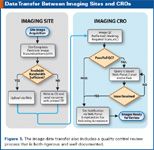Imaging Sites and Clinical Trial Harmony
How imaging CROs minimize data variability in multisite studies and create the necessary consistency.
Increasingly, medical imaging is seen as one of the answers to successful, cost-effective therapeutic drug development. The FDA's Critical Path Initiative, a national effort to modernize the scientific process through which a potential drug, biological product or medical device is transformed from a discovery into a medical product, underscores the growing emphasis placed on imaging in clinical trials. A recent report issued by the Initiative focuses on imaging as a core technology for the cost-effective assessment and acceleration of the therapeutic development process.

Clinical trials involving an imaging endpoint are typically conducted at multiple imaging centers that may have imaging equipment and acquisition differences. The use of imaging as a tool is more demanding in multisite clinical trials because data variability increases with the number of imaging sites. For images to be of maximum value to the drug development process, they must be acquired in a uniform manner. Harmonization of imaging procedures and the subsequent minimization of deviation in conduct and record across all sites is crucial to maintaining procedural precision and successful image transfer for independent review.
This article presents the necessary steps for standardizing imaging acquisition protocol and coordinating multisite imaging trials by identifying known variances and providing a means to minimize them.
Multisite studies and imaging CROs
In multisite studies, imaging centers may have differences in equipment, acquisition techniques, postprocessing software tools, and interpretation techniques. Although there is room for greater variance in the patient care procedures, site differences in clinical trials can cause high data variances that may limit the use of a study.

Figure 1. The image data transfer also includes a quality control review process that is both rigorous and well documented.
In clinical trials, supervising imaging centers is part of the overall medical imaging process, which is managed by an imaging CRO. Also known as imaging core laboratories or central imaging laboratories, imaging CROs manage the collection of consistent, high-quality imaging data and ensure minimal variability through central reading. When managing multisite imaging studies, the imaging CRO must take special consideration in each of the following areas to coordinate and standardize protocol to minimize data variability:
- Imaging charter and acquisition protocol design
- Qualification, coordination, startup, and management of imaging sites
- Image and data management
- Blinded, independent, centralized reading and interpretation
- Workflow management.
Charter and acquisition protocols
The imaging CRO can provide clinical trial sponsors with guidance in designing an appropriate Independent Imaging Review Charter (imaging charter) for submission to the FDA and is also responsible for the image acquisition protocol, typically as part of an image preparation and submission guide, developed before the study begins. The documents specify a standard manner for acquiring, managing, and assessing images to ensure that data from multiple imaging sites is collected consistently.
The imaging charter provides details of how reading interpretations will be executed with the central reviewers and documents how the reader(s) will be qualified and trained and the response criteria to be used. The charter serves as the official record of the central reading processes, and it is recommended that this document is submitted to the FDA for approval prior to the start of any central reads.
The acquisition protocol provides the study-specific details for image capture, such as a complete description of imaging parameters, appropriate instrumentation, timelines, subject positioning, etc. It includes standardized instructions for clinical investigators, as well as onsite imaging manuals for imaging technologists with information on the imaging procedure, equipment set-up, and format of radiological output.
It is the imaging CRO's responsibility to ensure that imaging documents apply accepted standards of GCP guidelines, including defining, monitoring, and auditing study methods and analysis during and after the study.
Site management
In conjunction with document development and approval, the imaging CRO assists the sponsor with locating and qualifying appropriate imaging sites. This includes remote or on-site preparation, such as a review of equipment variability and data transfer capabilities at participating facilities; hardware and software configurations, if necessary; and specialized technical support for all sites involved.
Technologists at imaging sites will receive training so that they fully understand the details of the acquisition protocol. In addition, the imaging CROs will prepare image preparation and submission guidelines and instruct imaging site personnel on the processes for delivering all images and data to the imaging CRO and for archiving relevant images and data on site.
The imaging CRO ensures that the image acquisition is managed according to protocol and constantly provides feedback to the imaging sites to ensure that consistent, high-quality data is obtained. To ensure protocol compliance and reduce data variability, continual review and monitoring of the imaging sites should occur over the duration of the trial as part of a rigorous and well-documented quality control process.
For example, the imaging site should be responsible for blinding any identifying patient data from image and data records before sending data to the imaging CRO. As part of the quality control process, the imaging CRO verifies the blinding of patient identifiers. The process should also include a thorough quality review of images received by the imaging CRO, as well as monitoring to ensure that the acquisition protocol is being followed. All deviations require the issuance of a query to the investigator site and should be recorded and archived. Throughout the study, a quality assurance review is also performed by the imaging CRO to determine that in-house procedures are being followed appropriately.
Image and data management
Image and data management includes the collection, verification, archiving, analysis, and submission of results to regulatory authorities when necessary. The imaging CRO manages all images and data within a validated system conforming to 21 CFR Part 11 requirements. Images and data must be tracked, documented, and securely archived as they are transferred to independent reviewers.
Images and data collected from multiple imaging sites will inevitably be delivered to the imaging CRO in many different formats. Depending on a site's technical capabilities, the imaging CRO may receive DVDs, tape drives, optical disks or even sheets of film or videocassettes. Data transfer between imaging sites and the imaging CRO may happen electronically or via overnight delivery service.
Even though modern imaging equipment is generally compliant with the DICOM (Digital Imaging and Communication in Medicine) standard, some devices produce files that need special decoding or translation. The imaging CRO will have specialized image processing software that can read and translate multiple electronic formats to a common file format, as well as the ability to digitize film and videocassettes. To reduce the potential for errors, this data management software should avoid the use of manual techniques as much as possible.
A multisite imaging clinical trial will result in mountains of electronic information. An imaging CRO should have the technology and skills to manage large volumes of data. This is particularly true when it comes to submitting studies. Secure electronic filing technology makes it easier for regulatory agency reviewers to access and wade through reams of data.
Reading services
Imaging CROs offer centralized blinded reading services from qualified radiologists that are independent of the sponsor and clinical imaging site. The centralized reading services model provides consistent results and has the least data variability.
Before the study begins, the imaging CRO will develop radiology review guidelines that detail the response criteria, review process, and training for the duration of the study. The most efficient imaging CROs will then train readers from the same hospital, university or reading services organization. This allows them to reduce reading variability because all physicians are similarly trained and have the same "reading culture." Any reading issues can be addressed immediately and consistently when all radiologists belong to the same organization.
Workflow management
Workflow management is a critical component of managing multisite clinical trials. An imaging CRO uses technology that is configurable to the specifications of each clinical trial, generating events, notifications, and task lists for each trial segment. For example, it can deliver to sites advance notification of subject visits to ensure site preparation and timely image receipt. Because receiving images from multiple sites can be complicated to track, good workflow management software delivers notification of receipt of scans to CRAs so that they can begin processing.
An imaging CRO with advanced workflow management software allows imaging sites with Web-based image and data transfer capabilities to send information directly via a secure portal. The best software provides a complete audit trail, centralized database, and image tracker that makes it easier to track the receipt and processing of images from multiple sites.
Conclusion
Significant differences in technology, image acquisition, postprocessing, interpretation techniques, and software can result in high data variability when conducting clinical trials at multiple imaging sites. However, a standardized protocol that is carefully managed and monitored can minimize data variability in multisite trials. This includes:
- Guidance in designing appropriate imaging charter and acquisition protocols
- Imaging site qualification and coordination, startup, and management, including acquiring and blinding images
- Image and data management, including collection, verification, archiving, analysis, and submission of nresults to regulatory authorities
- Blinded reading services from qualified radiologists independent of the sponsor and clinical site
- Workflow management services that generate and track events, notifications, and task lists for each trial segment.
Harmonization of these imaging procedures across multiple imaging sites provides trial sponsors with consistently uniform data that meet the standards of regulatory agencies.
Christina Mastandrea is director, clinical operations, at WorldCare Clinical, One Cambridge Center, Cambridge, MA 02142, (617) 250-5178.
SCOPE Summit 2025: Enhancing the Patient Experience Through Site Centricity
February 12th 2025In an interview with ACT senior editor Andy Studna at SCOPE Summit, Ashley Davidson, vice president, product lead - sponsor tech strategy, Advarra, highlights the need for more site-centric approaches in study startup.
